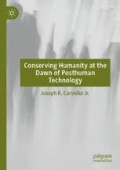Abstract
Mimetic isomorphism in organization theory refers to the tendency of one organism to imitate another in substance and structure, This concept may prove useful in fact, or at least as an apt metaphor, for how our ancestors mimicked nature to evolve into a creative species. Early inventions and artistic creations demonstrated that Homo sapiens were capable of shifting between thought processes, directed at first toward only concrete objects to eventually representational objects via abstract thoughts. In due course, we accumulated knowledge and understanding of the world, not only what lay beyond the human form, but within the human form, the biology-psychology of the anatomy and mind.
Access this chapter
Tax calculation will be finalised at checkout
Purchases are for personal use only
Notes
- 1.
At Jebel Irhoud, Morocco, in 2017, a former mine located 100 km west of Marrakesh, Levallois tools were discovered to have dated back approximately 315,000 years ago. See, https://www.nature.com/news/oldest-homo-sapiens-fossil-claim-rewrites-our-species-history-1.22114.
- 2.
Representational thought occurs whenever one thinks about his or her surroundings using images or language. PsychologyDictionary.org. See, https://psychologydictionary.org/.
- 3.
This according to a team led by archaeological scientist Daniel Richter and archaeologist Shannon McPherron at the Max Planck Institute for Evolutionary Anthropology.
- 4.
“All people today are classified as Homo sapiens. Our species of humans first began to evolve nearly 200,000 years ago in association with technologies not unlike those of the early Neandertals. It is now clear that early Homo sapiens, or modern humans, did not come after the Neandertals but were their contemporaries. However, it is likely that both modern humans and Neandertals descended from Homo heidelbergensis.” http://anthro.palomar.edu/homo2/mod_homo_4.htm (Last visited 8/7/2012).
Author information
Authors and Affiliations
Rights and permissions
Copyright information
© 2020 The Author(s)
About this chapter
Cite this chapter
Carvalko Jr., J.R. (2020). Signs of Mimetics. In: Conserving Humanity at the Dawn of Posthuman Technology. Palgrave Macmillan, Cham. https://doi.org/10.1007/978-3-030-26407-9_28
Download citation
DOI: https://doi.org/10.1007/978-3-030-26407-9_28
Published:
Publisher Name: Palgrave Macmillan, Cham
Print ISBN: 978-3-030-26406-2
Online ISBN: 978-3-030-26407-9
eBook Packages: Social SciencesSocial Sciences (R0)

